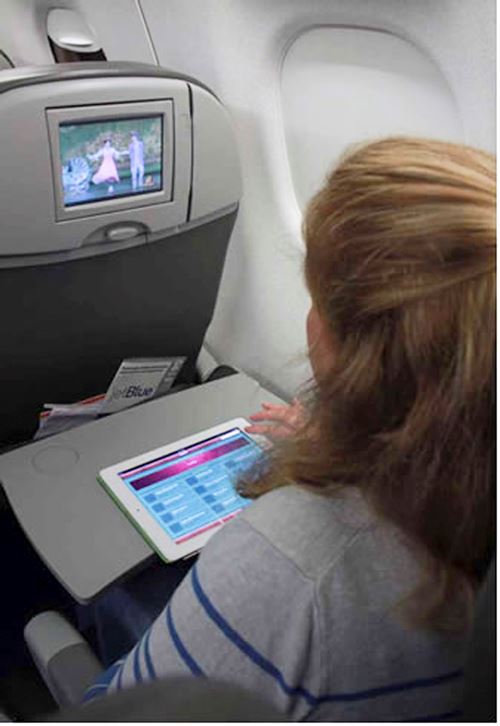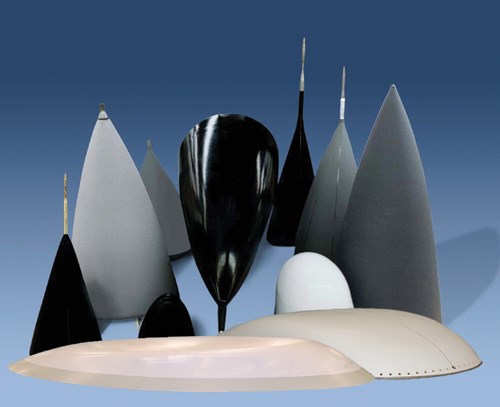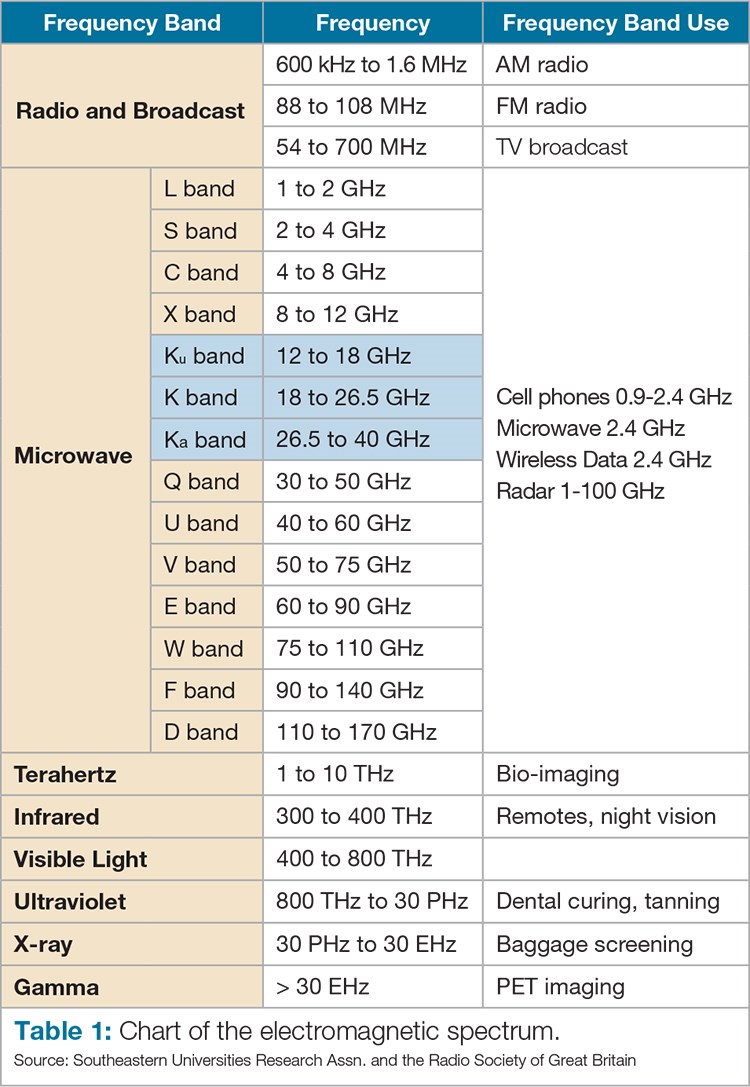Composites aid connectivity on commercial aircraft
General Dynamics’ triband radome helps LiveTV team overcome transmissivity challenges during development of in-flight broadband services.
Inflight entertainment and communications is a $2 billion industry, according to a 2012 report by MarketsandMarkets (M&M, Dallas, Texas), and by 2017, it could reach $3 billion. Beyond TV and video games, airline passengers now want to access a full range of services on their mobile devices, including smartphones and tablet PCs, at the same connection speeds they experience at home. By year’s end, according to the IFExpress web portal (http://airfax.com/blog/index.php/2013/01/08/2013-ifec-predictions/), “mobile Internet traffic will surpass fixed, and a lot of those users will be using them on planes.”
Foreseeing this trend, JetBlue Airways (Long Island City, N.Y.) announced in 2010 that it would develop and launch the industry’s best in-flight broadband for commercial flights, using ViaSat’s (Carlsbad, Calif.) innovative high-capacity satellite technology, with the bandwidth to meet growing demand.
That same year, General Dynamics Armament and Technical Products (GDATP, Charlotte, N.C.) developed a concept for a composite radome that would allow the enclosed antennae to transmit and receive radio frequency signals across a broader range of bandwidths. Thus, when LiveTV (Melbourne, Fla.), a wholly owned subsidiary of JetBlue Airways and the system integrator for the project, held a competition for such a radome in 2011, GDATP was well-positioned to meet the challenge. The company won a $10 million contract from LiveTV in 2012 to develop and produce triband radomes. Combined with ViaSat’s antennae and LiveTV’s onboard delivery systems, they would enable high-capacity two-way communications and Wi-Fi.
Broader bandwidth
Traditionally, bandwidth is a range of frequencies within a given band for transmitting signals, such as radio waves. But it also describes the amount of data that can be transferred over a connection per unit of time. Dial-up connections provide low- or narrow-bandwidth service. DSL, cable and satellites deliver high- or broad-bandwidth services (broadband, for short). A triband data connection is one that uses three bands, in this case, the K, Ku and Ka bands, to deliver as much signal bandwidth — that is, speed and connectivity — as possible.
These bands reside within the microwave part of the electromagnetic spectrum (see Table 1). as defined by the Radio Society of Great Britain (Bedford, U.K.). The K designation comes from the German word kurz, meaning short. Ka means “K-above”; and Ku means “K-under.” These terms describe the bands directly above and below the K band, respectively.
“We started this project in September 2010. JetBlue had just made the announcement to work with ViaSat, and three of our main competitors” — GoGo (Itasca, Ill.), Row44 (Westlake Village, Calif.) and Panasonic Avionics Corp. (Lake Forest, Calif.) — “had launched Air-to-Ground systems or were developing Ku-band satellite technology,” explains Mike Moeller, LiveTV’s VP of sales and marketing “We decided to bypass these due to our belief that the consumer demand for inflight Internet services was going to increase dramatically, and more bandwidth would be required to accommodate the desired speed and services to provide an ‘At Home in the Air’ experience.” Believing its product would need to withstand a large increase in demand over the next 10 years, LiveTV took the risk. “Our decision,” says Moeller, “was to pursue new technology that was not yet proven but would be groundbreaking if we could pull it off.”
That pursuit required a new kind of radome. Moeller notes, “We had to reach outside the traditional providers in commercial aviation, and identified General Dynamics, who had a vast experience in radome development.”
3x technical challenge
GDATP’s solution looks like other radomes, but that belies the technical achievement. “Typically, radomes are configured and optimized for a relatively narrow frequency bandwidth, for example, just Ka or just Ku,” says Daran Eastridge, GDATP senior program manager. Because LiveTV needed a triband solution, which meant optimizing a radome for a broad slice of frequency bandwidth, it also needed systems antennae to transmit and receive at these distinctly different frequencies simultaneously.
Developing a radome to accommodate a wide bandwidth is difficult because any material selected for the project will vary in its response to the electromagnetic waves passing through it. “At some frequencies, it will let the signals pass, and at others, the material will attenuate the signal,” Eastridge explains. “A stack of materials that will readily allow transmission at one frequency will often produce more loss at another frequency.”
For that reason, GDATP selected a quartz fiber/epoxy prepreg from TenCate Advanced Composites USA (Morgan Hill, Calif.) instead of a more conventional combination, such as glass fiber/epoxy or quartz/cyanante ester products. “We needed the transmissivity performance of quartz,” Eastridge explains. “However, quartz put a strain on the project budget. The design parameters allowed us to use TenCate’s epoxy resin, which helped us to meet both the desired performance and cost savings for this application.”
Beyond broadband transmissivity, the triband radome had to maintain the lowest possible profile to preserve aircraft aerodynamics and meet a strict weight requirement, yet provide ample clearance for the antenna hardware within.
Thus, the design process for a wide-bandwidth radome involves a complex analysis with many interdependent variables, including not only materials and the various signal processing options they offer, but also their shape and thickness. “You also must select materials that will enable consistency in signal transmission from part to part,” adds Eastridge. “Every radome on every plane must act the same and for a lifetime of 20 years or more.”
Experience provides solutions
Capability-wise, GDATP was in the right place at the right time. “Our military radome experience goes back to the late 1940s,” says Eastridge, “but we have also worked on commercial applications, including Boeing’s satellite-based Connexion inflight Internet service, launched in 2001.” He notes that military jets have been moving toward broadband for 20 years. “We have worked on ... the F-15 and F-18 radar modernization programs, and have developed a lot of experience in tailoring composites to uncharacteristically wide frequency bands.”
A key to success during those two decades was GDATP-developed proprietary radio frequency (RF) software, which is used to analyze the impact of various materials on RF signal transmission. “We can very accurately model what the impact of a given material will be and [do so] in a 3-D spatial configuration, including variations in radome geometry,” Eastridge points out. Beyond computer-aided signal modeling, GDATP has computer-aided structural analysis capabilities and uses them concurrently to iterate and refine the radome design. “The RF and structural designers work hand-in-hand, which cuts the time and cost of development.”
GDATP analyzed several radome profiles that LiveTV and ViaSat had identified as possible solutions along with options developed in-house, then performed trade studies to identify the optimal solution. “We had actually looked at this prior to being contacted by LiveTV,” explains Eastridge, “because we could see that aircraft communication systems were going toward Ka and Ku bands due to the advantage it offers for Internet service. So we already had a start on the problem when LiveTV contacted us.”
“This really benefitted us,” LiveTV’s Moeller acknowledges. “And they have so much expertise in highly technical radome development, it has helped guide the solution quickly, saving us valuable time and unnecessary expense.” Moeller adds that there is also a great deal of reliability in the GDATP radome.
The program concluded with testing to validate performance and certify first articles to U.S. Federal Aviation Admin. (FAA, Washington, D.C.) requirements — no small thing, Eastridge admits. “FAA certification requires extensive materials testing, as well as impact and lightning strike tests,” he explains. GDATP’s 16 different test ranges in Marion, Va., offer a wide range of RF, impact and load testing capabilities. “We are used to this,” he says, “and well-prepared for it.” As GDATP finishes the last of the FAA certification tests and prepares to deliver conforming units to JetBlue, Eastridge says the whole team is pleased with the radome’s performance, including ViaSat, which tested it independently.
When JetBlue launched LiveTV in 2010, offering 36 channels of DIRECTV broadcast on its aircraft, it committed to having the industry’s first in-flight broadband service by the first half of 2013. “That gave us a little over two years to get this right. But we’ve done it.” Although in-flight trials, FAA certification of other hardware, preparation for fleet-wide installation and lots of paperwork remain, “the whole team is committed and we remain on schedule for launch this year.”
Related Content
ASCEND program update: Designing next-gen, high-rate auto and aerospace composites
GKN Aerospace, McLaren Automotive and U.K.-based partners share goals and progress aiming at high-rate, Industry 4.0-enabled, sustainable materials and processes.
Read MorePlant tour: Albany Engineered Composites, Rochester, N.H., U.S.
Efficient, high-quality, well-controlled composites manufacturing at volume is the mantra for this 3D weaving specialist.
Read MoreManufacturing the MFFD thermoplastic composite fuselage
Demonstrator’s upper, lower shells and assembly prove materials and new processes for lighter, cheaper and more sustainable high-rate future aircraft.
Read MoreComposites manufacturing for general aviation aircraft
General aviation, certified and experimental, has increasingly embraced composites over the decades, a path further driven by leveraged innovation in materials and processes and the evolving AAM market.
Read MoreRead Next
Plant tour: Daher Shap’in TechCenter and composites production plant, Saint-Aignan-de-Grandlieu, France
Co-located R&D and production advance OOA thermosets, thermoplastics, welding, recycling and digital technologies for faster processing and certification of lighter, more sustainable composites.
Read MoreAll-recycled, needle-punched nonwoven CFRP slashes carbon footprint of Formula 2 seat
Dallara and Tenowo collaborate to produce a race-ready Formula 2 seat using recycled carbon fiber, reducing CO2 emissions by 97.5% compared to virgin materials.
Read MoreDeveloping bonded composite repair for ships, offshore units
Bureau Veritas and industry partners issue guidelines and pave the way for certification via StrengthBond Offshore project.
Read More

































